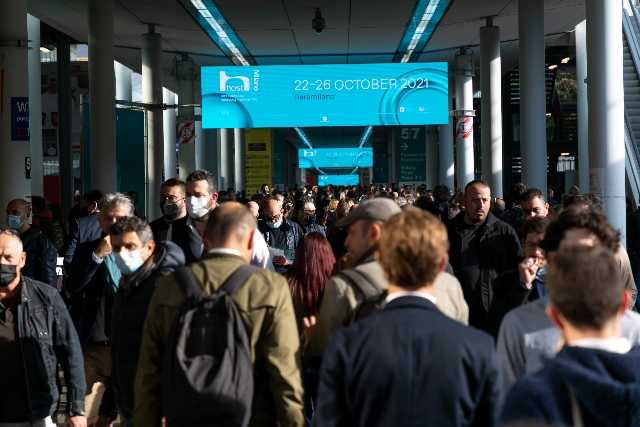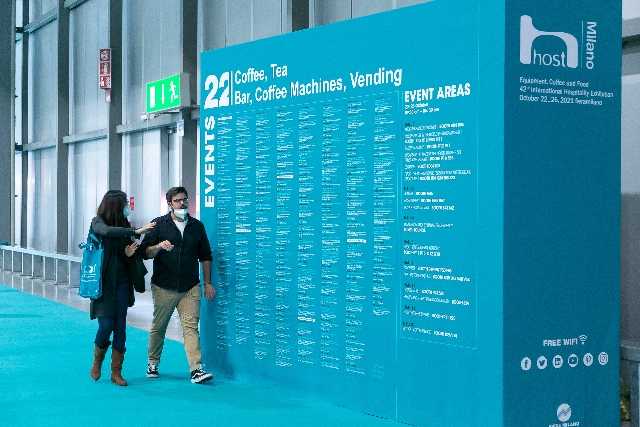MILAN, Italy – As the ribbon-cutting ceremony for Host 2023 approaches- at fieramilano in Rho from Friday, October 13 to Tuesday, October 17 – Host Milano proves to be the reference event to discover the trends that will influence business development in the coming years.
The most interesting cross-sectional datum that emerges from Host Milano’s constant dialogue and interaction with supply chain stakeholders is that never before have new consumption habits and technological innovation mutually influenced each other, generating a demand that fuels Research & Development investments and increases international trade.
Host: the economic impact of innovation
The industrial galaxy present at Host Milano is characterized by strong internationality, with significant global trade.
According to data from Export Planning, the world trade of the represented supply chains reached a new high of 178.3 billion euro in 2022, at levels well above pre-pandemic levels: 38 percentage points higher than 2019.
The most prominent sector is Table Furniture, which was worth close to 94 billion euro last year (+35% over 2019).
Professional Catering, on the other hand, experienced the strongest increase compared to pre-pandemic levels (+45% on 2019), approaching 75 billion euro last year.
The Coffee-Vending Machinery (+5.9%, almost 19 percentage points) and Bakery and Pastry Machinery (+3.4%, about 11 percentage points) segments also show significant increases compared to 2019.
Also of great interest are supplies for the Gelato sector, where Italian production is the leader with exports worth more than 2.3 billion euro in 2022 (more than a quarter of all EU exports), which will become 3.2 billion in 2026 thanks to a CAGR of +4.4%.

In ExportPlanning’s 2026 scenario, world trade in the group of products represented at HostMilano will increase at an average annual rate (CAGR) of +3.4% and exceed the 200 billion euro mark by the end of the period.
Looking in detail at some of the main markets, last year Germany boasted an interchange of almost 1.37 billion euro with Italy, of which two thirds (927 million euro) were Italian exports. Of great interest are the Gulf countries, which record an interchange of 1.2 billion euro with Europe.
The United States’ projection is even more global, which last year exchanged Host Milano products with the rest of the world worth no less than 47.8 billion euro.
As for the Italian industry, world leader in many areas of the sector, according to estimates by the Anima Assofoodtec Studies Office, by the end of 2023 Italian food service equipment will exceed 4.6 billion euro, to which exports will contribute more than 3 billion.
Italy alone, therefore, represents more than 10% of the entire world production value of this segment within the Professional Catering sector which, at global level, is estimated by Future Market Insights at around 44 billion dollars (76 billion in 2032, +5.6% on average).
Of particular note are refrigeration equipment and compressors, with 1,835 million euro, of which 1,052 from exports; bread, biscuit, pastry and pizza machines and ovens, worth 695 million euro (460 from abroad); and espresso coffee machines with 550 million euro (415 from exports).
Lifestyle experiences require smart technologies
A good example of how innovation and consumer trends influence each other is the evolution of food delivery, which will be represented at the event by several of the most significant leading players: no longer perceived simply as “good and fast”, but also and above all as “gourmet, practical and safe”, delivery is supported by increasingly smart machinery and products, right up to artificial intelligence that designs new recipes on the basis of consumption.
One new development concerns “where” food is consumed “to go”: people are eating less and less at home and more and more in outdoor spaces, especially parks.
From gourmet restaurants to food halls, many restaurateurs are following this trend by creating new recipes specifically designed for consumers who want to socialize outdoors with friends or family: again, generating a demand for specifically designed accessories and services.
This experiential trend, which emerged a few years ago and in which consumers seek immersive and multi-sensory lifestyle experiences in the out-of-home, is being strengthened by a greater emphasis on design: high quality in visible parts, also with regard to visible and table cooking, but also tableware designed for sharing and excellent presentations, where the contrast between all white and color and unusual combinations of materials dominate, e.g. precious porcelain with innovative and high-quality recycled plastics.
In this scenario, operators are increasingly focusing on the care of the formats and concepts of their establishments, but also paying special attention to sustainability: for example, with paneling made from recycled plant by-products, furniture made of hyper-durable materials that prolong the time needed for replacement, integration of IoT technologies that monitor consumption, or implementation of circular economy strategies that follow the customer throughout the product’s life cycle and then ensure that it is recycled or disposed of sustainably at the end of the cycle.
Experientiality stimulates technological innovation
Another confirmation is the desire to experience different cuisines: the flavors of global cuisines are continuing to move ahead at a rapid rate, with consumers increasingly interested in dishes from different culinary traditions.
The demand for flexible, multifunctional equipment such as combi ovens and flat griddles, as well as specialized equipment such as woks, sushi supplies, ‘robata’ grills, tandoori ovens and crèpe griddles is growing in parallel.
At the coffee shop, coffee and especially specialty coffee are a growing phenomenon, and hence hyper-connected machines that use machine learning to “learn” how to make coffee, then guide baristas step by step with all the factors for a perfect extraction.
Consumption changes, food equipment evolves
Rationalization of menus is also becoming a solution to rising costs and a static market, including by emphasizing innovation to use cheaper ingredients in dishes.
This is reflected, for example, in the use of cheaper cuts of meat, but especially in kitchen automation with modular solutions, plug-and-play equipment and connected systems. Multi-purpose equipment such as combi ovens and quick cooking ovens can help adapt to rapidly changing menus.
Finally, opportunities for eating throughout the day are becoming increasingly scarce. Remote working has overturned the concept of fixed hours: consumers eat what they want, when they want and where they want.
From brunch even during the week to healthy bowls even at breakfast, but also fusion and ethnic flavors. The impact is reflected in particular in a demand for innovative packaging for take-away and delivery, as well as fast cooking ovens to meet service times and pick-up boxes.
In Italy, growth in food equipment mirrors a return to out-of-home consumption, which is also confirmed by Fipe, the Italian Federation of Public Establishments.
In the second quarter of the year, according to Fipe-Confcommercio analysts, there was a positive variation compared to the previous quarter, with an increase of 28.7%, where, however, seasonal factors also weighed heavily on consumption in this sector.
The analysis by economic activity shows year-on-year increase for all sectors associated with the tourism industry, as a result of the full recovery of activities following the end of the pandemic.
Host 2023 will be an opportunity to discover next-generation innovation, with its business opportunities, both in the layout, with its more than 2,000 exhibitors, and in the program schedule with more than 800 events.
HostMilano will be held at fieramilano from 13 to 17 October 2023. For updated information click here.


















